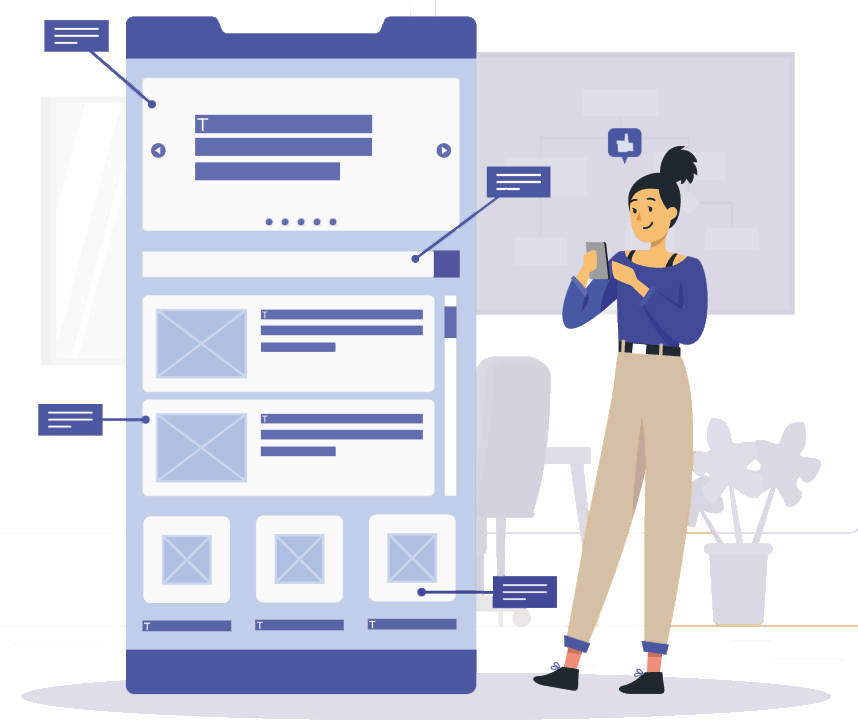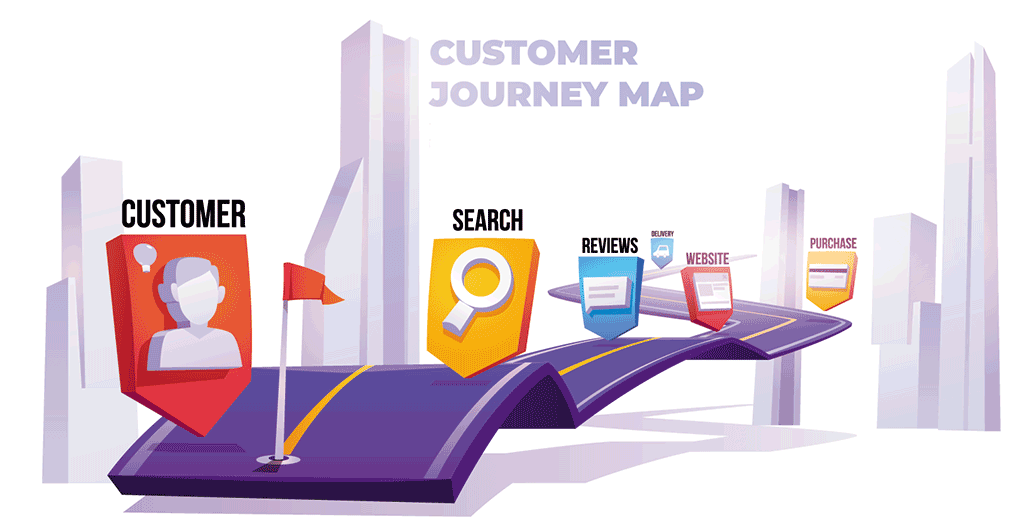Did you know that the customer journey is not always linear? Traditionally, it was thought that customers follow a linear path from awareness to consideration to purchase. However, in today's digital age, customers often engage in non-linear journeys, jumping between different touchpoints and channels, making it essential for businesses to have an omnichannel strategy.
Crafting an effective customer journey map is essential for businesses that want to maximize user experience, and customer involvement and optimize the entire experience. A well-crafted journey map can help companies gain insights into how customers interact with their brand and give them real-time feedback which they can use to make improvements in service quality or create more enjoyable experiences.
In this blog post, we'll look at the benefits of a strong customer mapping solution as well as tips on building one - from formulating strategies for creating these maps to assessing our designs' outcomes.
What is a Customer Journey Map?
A customer journey map is a visual representation of the interactions and experiences a customer has with your brand throughout their journey. It helps you understand the customer's emotions, needs, pain points, and challenges at each stage of their journey, from the initial awareness of your brand to the post-purchase experience.

Basics of Customer Mapping in Business
Creating an effective customer journey map is no walk in the park. It needs careful preparation, plentiful research, and an understanding of a customer's requirements and inclinations. To make sure that your customer journey map will be successful, it's critical to comprehend some fundamentals around mapping for business purposes. To get off on the right foot with your customer journey project it's important:
Firstly, identify who exactly should benefit from this service or product. Identifying and recognizing your target market is the first step in creating a product or service that meets their needs.
As well, you'll want to consider what motivates them to make purchases and why they may be hesitant when it comes to certain products or services.
It’s also important for businesses to identify any potential problems that arise during customer interactions so solutions can be created before launching campaigns or introducing new items.
Lastly, executives should think about how different channels such as mobile apps, websites, and social media platforms fit into the bigger picture of the customer experience map- this will ensure messages reach desired audiences without compromising quality standards! Coordinating marketing efforts between multiple channels allows businesses to achieve maximum results while still delivering top-notch services/products
Understanding these factors can help create an effective connection with customers which could bring greater loyalty and satisfaction.
Customer Journey vs. Buyer Journey
Understanding both the customer journey and the buyer journey is essential for businesses to effectively engage with customers, provide relevant information, and create a positive overall experience.
The customer journey encompasses all interactions and touchpoints with a brand, from the initial awareness and consideration stages, to the purchase and post-purchase stages. It takes into account the customer's emotions, preferences, and experiences at each stage of their relationship with the brand.
In contrast, the buyer journey is a narrower concept that specifically looks at the stages leading up to the purchase decision. It focuses on understanding the buyer's mindset, considerations, and decision-making process during the research and evaluation stages.
While the customer journey encompasses the entirety of the customer's experience, the buyer journey provides insights into the specific steps and actions that lead to the ultimate purchase.
Understanding the Importance of User Experience
Comprehending how vital user experience is for developing an effective customer journey chart is a must. UX design examines the entire customer voyage across all communication channels and devices. It takes into consideration customers’ sentiments, choices, encouragement, and behavior when engaging with a brand or product. This permits companies to gauge just how well their website and product offerings are appealing to their desired group of onlookers. Additionally, it enables them to comprehend which areas need enhancement so as to uplift deals, and empower loyalty among clients while reinforcing conversions in parallel!

Creating a successful customer journey map requires firms to take into account all aspects of the user experience. This includes not only the general appearance of websites, apps, or digital product offerings, but also things such as how quickly they navigate, usability features like page and product loading times that are responsive to browser size changes, and much more. Ensuring each step in customers’ journeys is designed from start to finish with their needs in mind is essential for engaging users and building trust in your brand.
It's equally crucial that you incorporate regular user testing when establishing a customer journey map so you understand how people interact with various digital touchpoints - this can give important insights on what exactly pages should look or do to create ideal experiences for clients. Carrying out these tests will help businesses make adjustments based on real-life feedback from individuals rather than just relying on speculation when considering design modifications or improvements.
Steps to Create an Effective Customer Journey Map
Creating an effective customer journey map is critical for businesses to understand the path a customer takes from the first point of contact with your company until they become loyal customers." Crafting this kind of impactful user experience will not only ensure that you keep your existing clients, but can also give you insights into what appeals to them and how their behavior changes over time. So let's take a look at some steps we could follow in order to create powerful customer journey maps:
Collect Touchpoint Relevant Information
Firstly, make sure that you have all relevant information about each touchpoint along the way – like interaction history between brand and consumer or feedback on products/services provided by the company. This data will help provide context as well as identify areas where improvements need to be made.
Set clear Objectives for the Map
Before diving into the mapping process, it's important to define clear objectives for your customer journey map. Consider what specific insights or improvements you want to gain from the map, such as identifying pain points, optimizing touchpoints, or enhancing the overall customer experience.
Profile your Buyer Personas and Behavior
Analyze any patterns in how consumers behave during their journey so that marketers are able to analyze when certain actions should be taken - such as providing incentives for completing surveys or providing additional purchase options at checkout stages, etc. Understanding these behavioral elements enables companies to determine what works best at different parts of users' journeys and helps increase conversion rates overall.
Visualize and Create a Strategy
Visualize your findings using diagrams that showcase individual steps within customers’ journeys clearly including start points, endpoints & key decision moments throughout the process (e.g.: A/B testing ) so everyone working on the project has a clear understanding of analyzed data & further actions needed.
Do A/B Testing
Lastly, test out new strategies based on collected info. Even though gathering insights through mapping might reveal valuable knowledge, there’s no guarantee of success unless tested; measuring performance post-implementation allows the team to adjust plans based on the progress achieved adding quality back loop activity into the cycle to track long-term effects introduced changes had across the firm ecosystem.

It's just as important to understand how customers feel, on their journey through your Love Story with them. Frustration when they can't find the product; happiness at finding a new offer; confusion if the page isn’t what they expect and shock when seeing price increases – all these feelings must be understood for you to drive up conversions and revenue. So once you've mapped out that journey don't leave it there! Test campaigns across channels such as email or social media using different strategies tailored specifically to those personas - this will help identify which works best so you can build upon that success going forward. Have fun experimenting and uncovering customer insights along the way!
The Role of Journey Design in Customer Mapping
Good customer journey mapping is key to building a great experience for your customers. It's all about looking at the entire process from beginning to end and making improvements along the way. And nailing this comes down to understanding how you design their journeys with your product or service - it requires knowing where they've been so far as well as what they need to move ahead confidently.
How do you make sure each step of their progression feels natural? What tools can be employed that will help tailor an individual's experience? These are some questions worth asking when designing those special paths!
Understanding customers' behavior is a challenging process, yet essential to success. Crafting user flow diagrams or customer journeys requires creative thinking that delves into how people interact with your business through various channels - both online and offline- every step of their journey in association with you. It's not just about meeting the expectations but going beyond that whenever feasible which can be achieved by understanding what they need at each stage of it.
By analyzing why customers take certain steps, we get an idea of how to design these experiences to meet consumer needs better.
By analyzing how customers interact with your brand through different touchpoints and along their journey, you can spot possible areas for improvement or where extra support may be needed.
This way, the customer's experience is optimized from start to finish giving your business a competitive advantage in the market by providing smooth experiences across all channels and platforms. All of this starts with having empathy towards customers—truly understanding who they are as people, what it is that they want from engaging with your company, and why they make certain decisions throughout their journey.
Do we offer them enough opportunities? Are our expectations realistic? How could we do better at connecting on an emotional level? These are just some of the questions that should come into play when creating any kind of customer journey map.
Having a holistic view of data when mapping customer journeys can be extremely effective. All sorts of information, such as demographic info like age and gender, behavioral patterns like website or mobile app usage, emotional factors like how customers feel – all these types of details need to be taken into consideration for journey design to have an impact.
This way you're able to uncover insights about what your customers need that would otherwise remain hidden if journey design wasn't part of the process.
Adding a human-centered approach to designing customer journeys will create more engaging experiences that lead people not only to feel satisfied but also make it easier for businesses to reach their goals - making strong journey designs essential for successful customer Journey Mapping!

Why is Customer Journey Mapping Important?
Customer Journey Mapping is important because it allows businesses to visualize the entire customer journey, enabling them to identify pain points, improve touchpoints, and deliver a seamless and personalized experience. By understanding the customer's perspective, businesses can make informed decisions to enhance the overall customer experience and drive customer loyalty.
Strategies for Effective Customer Engagement Optimization
Customer journey mapping is an effective strategy that businesses can use to optimize customer engagement. But, as with any approach, it's essential to be strategic about the bigger picture to succeed. To optimize customer engagement throughout their journey, businesses can implement several strategies:
Understanding Customer Needs in Journey Mapping
Primarily, understanding what customers need before they even come into contact with your business should become a priority when looking at customer journey mapping. Afterward, you have to think of how to involve them throughout their entire experience – making sure that every second matters and turns out beneficial for both sides.
Enhancing Customer Engagement with Data-Driven Insights
One way of guaranteeing optimal optimization within customer engagement lies in using data-driven insights alongside personalized content provisioning. Getting insights about customer experiences from the past and present can help businesses identify potential issues like long wait times or lack of selection, allowing them to improve their services. Going one step further with predictive analytics could also be beneficial in creating personalized content that is specifically tailored for each individual – this way companies will anticipate what customers need and provide relevant information instantly.
Consistency Across Omnichannel Customer Interactions and Prioritizing Customer Satisfaction
To make sure everyone has a great experience there should be an omnichannel approach available as well. No matter where your customers interact with your brand - whether it be online, in person, or on the phone – they should receive a consistent experience.
For instance, if someone contacts you for support via phone they ought to get precisely the same level of service as if contacting by chat or email. Providing an omnichannel approach will give you more possibilities to meet customer requirements across various platforms and consequently raise satisfaction levels. This isn't just about delivering great customer service though; how customers feel treated when interacting with your business is increasingly important these days too!
Are you doing enough to ensure that your consumers are feeling taken care of?
Comprehensive Approach to Touchpoints and KPIs in Customer Journey Mapping
Finally, it's essential to think of all possible touchpoints when developing an effective customer journey map. This is not just limited to customary points such as website visits and sales calls but further contains interactions like social media comments, reviews, emails etcetera. Moreover, keeping a tab on the appropriate KPIs (key performance indicators) will help you calculate which touchpoints are doing good and vice versa. Then with this data at your disposal, you can start outlining methods for optimizing participation in each step so that you give customers the best experience ever!
Case Studies of Successful Customer Journey Maps
Creating a customer journey map is no piece of cake. It requires knowledge and plotting out the steps a client would take to buy something from your business or do whatever else you might want them to accomplish, like signing up for your mailing list for example. There have been some instances in which businesses constructed prosperous maps and utilized them as an effective part of their marketing approaches.
Take one travel company's case: they wanted their customers to book trips directly through them online instead of visiting another website etc..
First, they figured out where their potential customers were hanging around online (Twitter, travel websites, and so on).
Next up was creating a "journey map" to show the steps it took for a customer landing at their homepage to eventually book a trip. This involved finding points along this journey that could deter users from continuing and coming up with solutions for those areas.
To measure how successful the entire process had been in getting people through booking trips, analytics data was used - gauging drop-off rates during various stages of funnels as well as incentives needed to keep them going further down until completion.
This data enabled them to modify their journey map in the hopes of achieving higher returns. The outcome? A 25% spike in conversions! This was convincing evidence that this particular approach had been successful for them.
The same company also wanted insight on how customers who already owned their product interacted with it, so they could create similar journeys for new users or those not having a great experience on the site.
They wanted to make sure that every user had the best possible experience, so they came up with a plan. They mapped out each customer's journey using analytics data and user feedback -
what pages were accessed most often? What features did users interact with? How much time was spent completing certain tasks for example?
With this information, they could identify any trends within user journeys that indicated areas where users weren't having an ideal experience. This enabled them to pinpoint potential problems and address those issues accordingly to ensure everyone enjoyed the highest quality service.
Creating tailored customer journeys for different types of customers on their website helped them see an increase in page views by 30%. This demonstrates that customer journey mapping is effective and can be a great tool to get real results if used correctly with the right strategy. Companies should understand how the target audience behaves, analyze data accurately, and make improvements based on these insights so they know what works best when it comes to prospects engaging with their business online. Doing this will give clarity into pathways available for any type of consumer while improving user experience and eventually boosting conversion rates too! The question remains: Are you making use of all potential opportunities?
Common Pitfalls in Customer Journey Mapping to Avoid
Creating an effective customer journey map is beneficial for businesses, helping them understand their customers’ behavior and craft strategies accordingly. However, many companies fail to realize optimal results as they make mistakes or fall into certain pitfalls when creating these maps. We'll go over some of the most frequent ones in order not to repeat them and get our desired outcomes!
Negligence of Customer Feedback
One major issue that arises is neglecting customers' feedback. It's essential to actively listen to what your clients have to say; after all, it provides valuable insights that will help you create a better product/service with fewer flaws! If you're in business, the best way to get to know what's going on for your customers is by investing time and energy into listening carefully to their feedback. This helps businesses understand how clients think and act as they interact with the brand or use its services - something that can be easily overlooked if no questions are asked or customer reviews are ignored.
Not giving attention here could mean creating incomplete journey maps which don't help achieve a goal of improving experience both now and potentially in future scenarios too.
Complicated Strategy and Process
It’s also a common mistake when companies over-complicate things; filling their maps up with so much information it becomes difficult for them to interpret it properly or take any meaningful insights from them either! It should always be kept simple – this makes sure everyone has an easy understanding of all touchpoints within a process while enabling quick action around key areas based on achievable goals such as amazing customer experiences at every point!
Future Trends in Customer Journey Mapping
As customer expectations and how products and services are delivered keep changing, customer journey mapping has become more important for businesses of all kinds. Although there's no single formula for creating a successful map of the customer experience, taking into account certain fundamentals must be part priority when making decisions. Looking ahead companies may start applying AI or IoT in their methodologies for analyzing consumer journeys as well. But is this necessary? Will it make anything better than what we have now? That remains to be seen!
AI can assist brands in understanding consumer behavior better for them to more effectively target their marketing efforts.
IoT, on the other hand, helps companies collect real-time data related to what customers are doing. Moreover, virtual reality and augmented reality could be part of customer journey maps which would provide interactive experiences making it easier for consumers to find products or services they need.
Companies have also started exploring predictive analytics to anticipate customer needs before customers become aware of such needs themselves. With technology like this at hand, businesses gain insight into how clients interact with them throughout every step along the way - enabling more informed decisions based on those insights! This is incredibly helpful as it allows brands a means by which they can connect with their audience - understanding exactly what they require from start right through until completion!

In conclusion, creating a successful customer journey map takes dedication and knowledge in areas like user experience, mapping customers' journeys, designing engagement strategies as well and optimizing their experiences. Define the goal for your journey clearly before you start setting out on it and stick to one consistent approach while doing so. With thorough planning that involves some research into how people interact with different services or products, an effective customer journey map can be constructed - offering valuable insights about these interactions. Who wouldn't want to know what kind of positive impacts this could have?
If you are a business seeking to augment customer engagement or wanting to improve comprehension of the journey your customer embarks on what propels them into taking action? In that case, Salestown CRM is precisely the tool for you. Our effective software assists in mapping out your consumer's journey, unveiling their requirements, inclinations, incentives, Achilles heels as well as feelings at each juncture of the relationship. Make full use of your investment with Salestown’s impressive discernment and book yourself onto a Free Demo! With our team comprising committed professionals, we can facilitate converting engagement into success.
